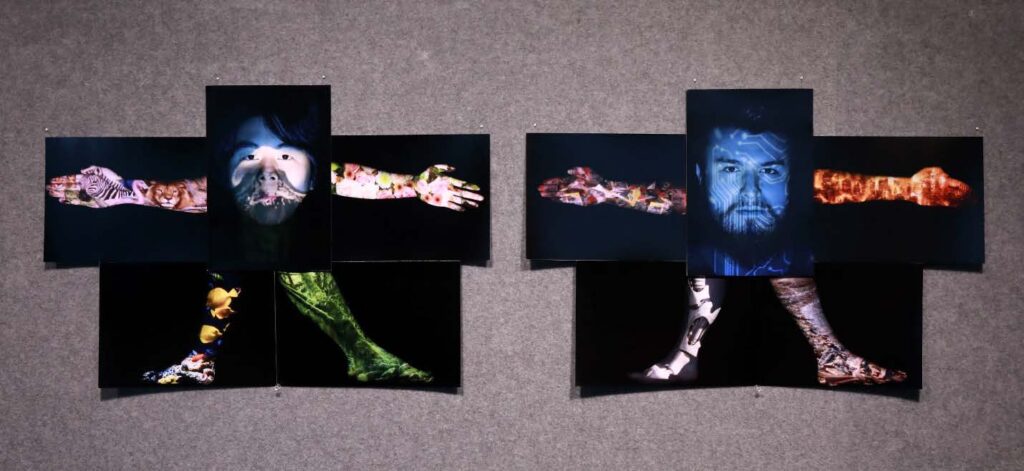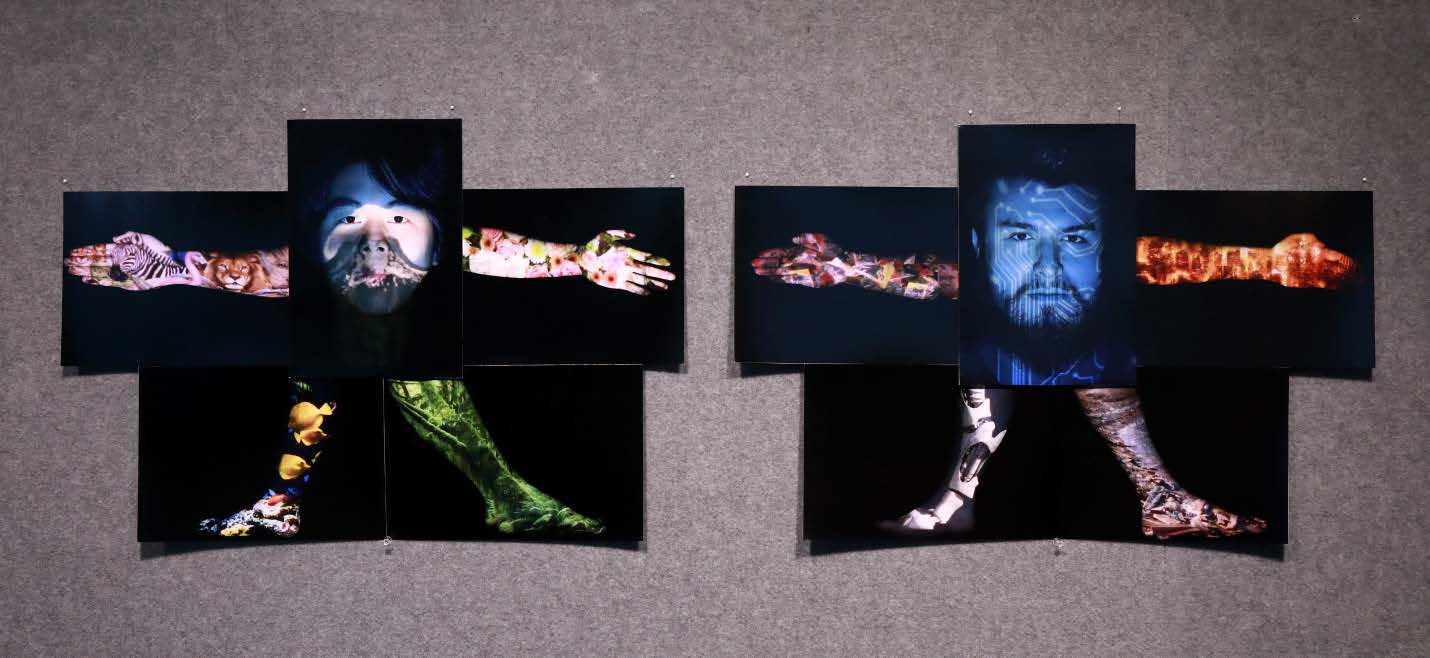The resulting body of work was created through a collaboration of Photographers: Jon Matthieu and Jake Jalsovec, focusing on the experimentation of projection as a creative tool in photography, and how it may be used to further enhance the communication of a works concept towards its viewer.
The inspiration of the series derives from the initial idea of positioning projections onto the human body as English Fashion Photographer John French demonstrates in his various projection works. While the conceptual meaning and presentation of the pieces as an obscure human like creature, a ‘mister potato head’, originates from the works of installation artist Tony Oursler, who’s installation works involve projecting videos of his various body parts onto shaped objects which together differ from the natural human form.
As a result, the collaborative series forms around the conceptual idea of what we as humans are connected to, one being the idea of how we originate and continue to be connected to Mother Nature and its immeasurable beauty. Or as humans being connected to technology and the advancements which we continue to make in society that causes far more harm than good, slowly manifesting over our interpersonal relationship with Mother Nature; thus turning ourselves into less of a human being and more of something inhuman or unnatural.

Mr Potato Head 1 & 2, 2017
Inkjet Prints
Jon Matthieu and Jake Jalsovec
For the Final Collaborative Assignment Jonathan and myself had decided to explore projection works and their capabilities in Photography. This initial idea had us searching for other artist who we could bounce our ideas off of and think of what kind of series we would like to make, thus our inspiration has come from two artist, English Fashion Photographer John French and American Installation Artist Tony Oursler.
Our first inspiration comes from the projection works of John French. His incorporation of projections onto the human body appear perfectly joined together, as if the models were wearing floral patterns which he commonly used throughout his practice. This appearance of the projection and body joined together gave us the idea of togetherness; of how the body and projection, whatever it may be, have a interpersonal connection with one another and work together as a whole. This also lead to the inspiration of the idea for our final concept being mankind’s relationship with both nature and technology, and how the two are a part of mankind regardless of whether it is natural or manmade.
The second artist who inspired our series is Tony Oursler, an artist whose installation works also include the use of projection onto a subject. However unlike John French, Oursler projects videos of various parts of the human face onto still life which may be oddly shaped or obscurely sized in comparison to the human face. This intern creates a figure which has humanistic traits but does not appear human, rather something resembling a mutant, or as we had decided to present the series as two figures without torsos. Although our final series does not explore strange shaped objects acting as canvases for the projections, we had originally explored this idea with an earlier experimentation during shooting which resembles the ‘Obscura’ installation piece by Oursler, by projecting human body parts such as an eye onto a round foam ball.
We had also found various projection images found through Google images which demonstrated different ways in which we could position or frame the projection, and therefore create different effects (as seen with the images below), giving us possibilities of exploration besides directly projecting the image onto an object. These alternative projections included projecting the image from behind the subject, projecting the image to surround the subject rather than directing it onto the said object or projecting directly above at a bird’s eye view to again create a surrounding effect through the projection.
We had originally had the idea of projecting various patterns and designs onto cameras which would represent the style of photographs that would be an outcome of the particular camera. So for this we thought of using a DSLR, SLR 35mm Camera, TLR and Polaroid to show various characteristics. This later evolved into seeing if we could project a human feature, more specifically an eye, first onto a Foam ball (Fig.1 & 2) which produced a well detailed and clearly exposed image of the eyeball. This idea was however dropped due to the lack of still objects we had available which could display clear and properly exposed images for various body parts. After this we had also tried clearly exposing the eyeball onto one of the cameras provided (Fig.3). This however followed similar problems as previously with the overall texture of the cameras being too rough and detailed in the digital images shot. Therefore causing the projection of the eyeball to appear as if it is out of focus, and thus why the idea of combining human body parts with cameras was also dropped. This experimentation however helped us to realise that in order to produce a sharp and clear projection we would need to project the images onto a smooth and bright coloured surface, with minimal visible texture of the object.
From this point we decided to relook at our series as a whole and think of a new concept and way in which we could incorporate projection with our photography. After reflecting on the works produced by our inspirational artists, we slowly came to the final idea of our series, with many notes and plans written down on paper which slowly built the final concept (Fig.4 & 5). The final idea which we have conceived is the idea of how both nature and technology have now become a part of the human race, how we have our connection towards nature while also having a connection with technology. But we put the two side by side as opposites, nature being seen as good while technology as evil. The series challenges the idea of how far technology will take us to the point where we no longer have our connection with nature and become less human because of these advancements.
These notes include not only the layout of the images but what images we would source from the internet to use as projections in order to best communicate our concept towards the viewer.
On the next few pages are the images which have been sourced for each body part, with the images used for the nature piece on the left, while the images used for technology on the right. We made sure with the sourced images used that they were of a high resolution (anything above 1024 pixels wide) so that we could have the highest quality projection possible since the projector used was not a high end performing projector. Although the images are in proper sizing, we did have to expand, slim or multiply each individual image in order to achieve the perfect projection onto the subjects’ body part, so that it may appear seamless on the subjects’ body, as French had demonstrated in his works. This can be seen in Fig.6, where the image of a mountain had to be slimmed in order to more easily identify it on the subjects face.
In preparation of the final presentation, Jake and I had selected the final ten images together after shooting, as well as decided to use the Canson Platine Fibre Rag paper as it was deemed the most appropriate paper to print and display the series. Working to our strengths, Jonathan edited and printed the series while I worked on the theory of the assignment. We both crosschecked our respective final drafts before presenting a final output.
Below is an image of the final works and how we chose to display the series together. The obscure creation of the human like figures clearly being seen in the final outcome of the series.
